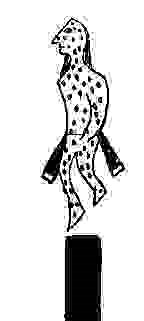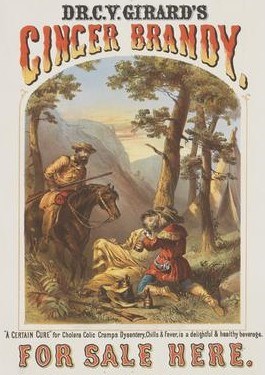
Image by James Mooney. Original artwork by a member of the Kiowa tribe. Seventeenth Annual Report of the Bureau of American Ethnology to the Smithsonian Institution, 1895-96. 
Beginning with the smallpox epidemic that swept across the southern Plains in 1816, successive waves of invisible enemies played havoc with tribal societies. Cholera came west with the California gold-seekers in 1849. The Kiowas believe they lost half their tribe to the "cramps" in that year. (Cholera was accompanied by severe abdominal discomfort.) The Comanches, which may have numbered 20,000 in the late 1700s before the coming of the Anglos, were reduced to 2,000 by the end of the 1800s. The number of Jicarilla Apaches was down to less than 600 by the early 1900s due to tuberculosis and other diseases. In 1854, smallpox erupted among the Ute tribe. It may be have been transmitted to the tribe in coats provided by Indian Agent Kit Carson. The Utes retaliated by attacking Anglo settlements in southeastern Colorado. Mrs. Kennedy's Ordeal When Col. Edwin Sumner was put in charge of the brand new Department of New Mexico in spring of 1851, he took on the task of re-organizing Army posts in the territory (and choosing the location of Fort Union). He marched out of Fort Leavenworth in eastern Kansas in May 1851 to take on his new assignment with a contingent of officers and some 600 new recruits. Almost immediately, cholera began spreading through the ranks. Within a week, during a difficult stream crossing in heavy rain, senior medical officer Dr. Alfred Kennedy was struck by the contagion. He was dead within six hours, his wife and two small children at his side. Capt. John Pope was charged with leading an escort for the Kennedy family and the doctor's corpse back to Kansas City, where Mrs. Kennedy had family. Pope fashioned a coffin out of the doctor's bed frame, but lacked enough wood for a cover. It was still raining when the travelers set out for Kansas City, making stream crossings very challenging. The entire second day was spent getting horses and carriages across a swollen creek in the rain. That night, Mrs. Kennedy's small son was stricken with cholera. The next morning, the boy, too, died. With the rain continuing, Capt. Pope chose an alternate route, hoping for better road conditions as Mrs. Kennedy traveled with her dead child in her arms. With the alternate route equally difficult, the party returned to their original path very late at night. "The [doctor's] body had by this time become so offensive that it was extremely unpleasant to approach it," Captain Pope wrote. Finally, on the fourth day, the party reached Kansas City, arriving there after 1 o'clock in the morning. Throughout the rain, mud and emotional toil, Mrs. Kennedy "bore it with a stout heart, and her noble and resolute conduct had the most salutary effect upon the men who had shown strong intentions of deserting," Pope wrote. Army MedicineAs the U.S. Army expanded westward, so did medical care, since a post infirmary was an essential part of typical frontier forts. Fort Union, for example, boasted the finest medical facility for hundreds of miles. Yet the presence of advanced medicine was not necessarily a boon for the natives, many of whom avoided it like the plague. (The dichotomy between traditional tribal remedies and Anglo medicine still resonates in Indian Country today.)Cholera swept across the Santa Fe Trail right after the Civil War. When a unit of Buffalo Soldiers (newly enrolled African American troops) arrived at Fort Union after marching 500 miles across the prairie, the post surgeon banned them from the fort. He quarantined them about 20 miles north of the fort for a few weeks.

Library of Congress By the late 1800s, tuberculosis was a scourge, particularly in the Indian schools run by the government. While the government was trying to assimilate the Indians by "educating" their children, Indian parents were afraid to send their children to those very same schools. Infectious Disease at Fort Union There were occasional, isolated cases of smallpox at Fort Union in the 1870s. The post surgeon usually blamed them on visits to Loma Parda, an "entertainment" district with dance halls, brothels and saloons about five miles from the fort. Minor outbreaks were treated with localized quarantines within the fort. The most serious smallpox outbreak at the fort occurred in the winter of 1877-78. | ||||||||||
Last updated: January 22, 2021
